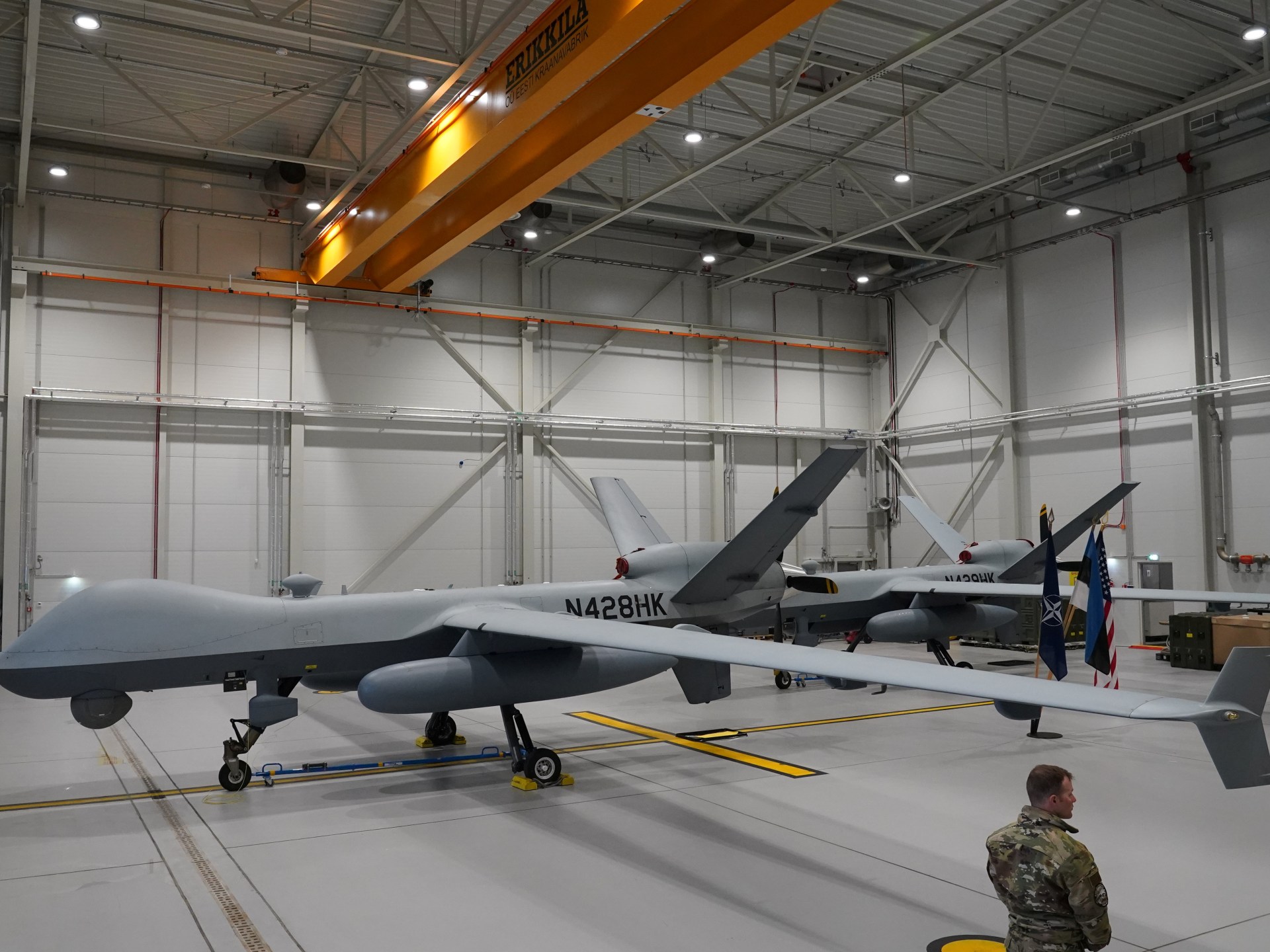Short on time, Biden sought new Ukraine tank plan to break stalemate
In a late morning call with Scholz from the White House on Jan. 17, Biden tried several tacks.
Britain had announced it would send 14 of its Challenger tanks, he reminded Scholz, addressing the chancellor’s concern that Germany not be the first to challenge the Russians by giving Ukraine a major new weapons system. The United States and other NATO partners, following mid-December consultations among the “Quad” of U.S., British, French and German leaders, had tentatively approved the transfer of hundreds of lesser, but effective, armored combat vehicles, he said, including American Bradleys and Strykers.
Scholz did not budge. Berlin and Washington must face down Moscow in lockstep, he told the president. Germany would not send its main battle tanks if the United States continued to decline sending some of its own — the powerful Abrams M1.
“I think the chancellor had the impression … he made a good case,” a German official said. Biden told Scholz he would “get back to you,” the official said.
Two of Biden’s closest foreign policy aides had been listening in, and after he hung up the three men sat alone rehashing the disappointing call. Jake Sullivan, the president’s national security adviser, and Secretary of State Antony Blinken had helped him navigate countless national security crises over the years — Blinken since Biden’s Senate days and Sullivan during his vice presidency.
The longer the increasingly public disagreement over tanks went on, Biden worried, the more damage it was doing to his top priority on Ukraine: maintaining U.S.-led Western unity in the face of Russian aggression. Military leaders from the dozens of countries supporting Ukraine were meeting in three days at the U.S. base in Germany, and everybody wanted an answer to the tank dispute.
“How do we move forward?” Biden asked the two.
It was Blinken who suggested a possible workaround. What if they announced a commitment to supply M1s but at some future point as part of Kyiv’s “long term” needs in a war that might go on for years? It could provide Scholz with the cover he sought to allow the Leopards to move right away. At the same time, it would give the Pentagon — where Defense Secretary Lloyd Austin was against supplying Abrams tanks he thought were too complicated for near-term use in Ukraine — time to address concerns about training Ukrainian forces on how to use them and setting up the necessary logistics.
Barely a week later, Biden appeared in the White House Roosevelt Room to announce that, on Austin’s recommendation, “the United States will be sending 31 Abrams tanks to Ukraine.” Thanks to Scholz, he said, Germany was providing Leopards from its own arsenal, “and will lead an effort to organize the European contribution” of dozens more.
“We are fully, thoroughly, totally united,” said Biden, with Austin and Blinken standing by his side.
This account of how extended allied discord turned around in the space of barely a week was compiled from conversations with more than a dozen current and former officials and people familiar with events and closed-door consultations on both sides of the Atlantic. Most discussed the still-sensitive issue on the condition of anonymity. The White House, Pentagon and State Department declined to comment.
In the aftermath of the deal, success claimed many fathers. The administration said it demonstrated Biden’s clear commitment to go the distance with Ukraine and keep the support coalition together. Scholz, whose reputation for dithering had been coined as “Scholzing” in Ukrainian memes last summer, said in a Wednesday radio interview that the real meaning of the term was “Germany does the most.”
Ukrainian President Volodymyr Zelensky, whose urgent appeals for more and better military equipment over the past year have sometimes sounded like criticism to a frustrated West, told SkyNews on Wednesday that “overall I am grateful to the world for their support … But if we are talking frankly and honestly … we have approved cases of weapons to be sent to us, but we still haven’t received them.”
Since Russia invaded Ukraine nearly a year ago, aid from the United States and its allies has repeatedly “evolved,” in the words of many officials, to respond to battlefield needs, even as its sometimes slow pace has reflected their reluctance to provoke Moscow. It began with short-range defensive weapons that helped repel Moscow’s initial attack on Kyiv. When regrouped Russian forces began to push into Ukraine last spring along a lengthy front line in the east, the United States, Europe and others began sending their toughest artillery.
Washington hesitated when the Ukrainians asked for the High Mobility Artillery Rocket Systems, the multiple-launch HIMARS that would allow longer range, precision strikes behind Russian lines. But by late summer, the United States relented and Kyiv was hammering enemy command centers and ammunition depots — allowing Ukraine’s forces to reclaim significant swaths of Russian-occupied territory.
In early fall, just as a debate revved up over Ukraine’s request for heavy tanks and armored vehicles to push Moscow’s forces even farther back, attention was abruptly diverted to the need for a different kind of weapon. Russian President Vladimir Putin had responded to Ukrainian successes on the ground by ordering massive missile and drone attacks on civilian areas and infrastructure, far from the front lines.
Major cities without electricity and heat, apartment buildings reduced to rubble and massive civilian casualties overwhelmed allied concern that Putin might use the transfer of some of the West’s most advanced weapons as an excuse to attack NATO countries. They quickly agreed to supply sophisticated air defense systems, including Patriot missile batteries.
The air barrage continued into winter, even as ground forces on both sides slowed their efforts to advance through the inhospitable weather and prepared for the second spring of the war. The United States and its partners announced they would use the time to train thousands of Ukrainian soldiers in a smarter way to attack entrenched Russian lines, with infantry protected by armored vehicles.
Armor, they agreed, could carry troops across the broad flat fields of eastern and southern Ukraine, and fire big guns to clear their path. They pledged new systems of fighting vehicles, such as U.S. Bradleys, German Marders, and French AMX 10-RCs.
But the heavy battle tanks that Ukraine wanted were another question. Austin considered the Abrams M1s operationally and logistically too difficult. He thought Kyiv already had enough Soviet-era models — hundreds taken from its own arsenals, captured from retreating Russians, or donated by other NATO members that were once part of the Soviet bloc. As far as he was concerned, the U.S. tanks were out of the question.
A retired Army general who helped lead the 3rd Infantry Division’s invasion of Iraq with M1s in 2003, Austin was convinced, a senior defense official said, that the massive battle tanks would be “impossible” for the Ukrainians to sustain and maintain. At the same time, a second defense official said, the U.S. vehicles were clad with specialized, depleted uranium armor, a classified design that no one wanted Russia to get its hands on.
Ukraine’s appeals made little headway until Zelensky traveled to Washington four days before Christmas to make his case, in private to Biden, and in a public address to Congress.
“It is just a matter of time when they will strike against your other allies if we do not stop them now,” he told lawmakers. “We must do it. I believe there should be no taboos between us in our alliance. Ukraine never asked the American soldiers to fight on our land instead of us. I assure you that Ukrainian soldiers can perfectly operate American tanks and planes themselves.”
The answer to his plea was an announcement of the more lightly armored fighting vehicles, and Britain’s pledge to send 14 of its Challenger 2 main battle tanks. But rather than calm the roiling allied waters, discussion about more heavy tanks gained speed in Europe, with pressure on Germany. There are about 2,000 of German-made Leopards in Berlin’s arsenal and spread across the world, primarily in Europe. But any other country that wanted to transfer them to Ukraine would need a German re-export license.
“It was clear from that moment that the question would be whether Germany would provide the Leopards,” the German official said. From the outside, it seemed a simple question. The German-built vehicles were far more simple to use than M1s, with an abundance of available spare parts, and other nearby countries were willing to send them to the battlefield.
But for Scholz, it was a significant political dilemma. Since the early days of the war, he had tried not to appear ahead of the pack when it came to arming Ukraine, expressing concerns over Moscow’s potential retaliation, or being seen as a direct participant.
Many in his governing coalition were pressing him to move forward, even as some in his own Social Democratic Party were less enthusiastic, and polls indicated a closely divided populace. Dueling images were at play, neither of which looked ideal — Germany as a reluctant partner in the worldwide coalition against Russian efforts to quash Ukrainian democracy, versus the sight of German tanks rolling across Europe for the first time since World War II.
Turning up the heat on Berlin
In Europe, potential Leopard providers focused on ramping up pressure on Berlin through carefully crafted public messages, according to a senior official from Poland, which had its own Leopards.
“The Ukrainians really wanted a country that would openly say they were sending tanks to open the way to others, and they asked Poland to be the first one. … We were sure that Germany sooner or later would succumb … there’s no way they can say no to so many countries,” the official said.
The method had already proved useful. In November, after Germany offered one of its U.S.-made Patriot systems to Poland when an errant missile landed inside the Polish border, Polish Defense Minister Mariusz Blaszczak announced he had asked Germany for permission to re-export that battery to Ukraine. In short order, the United States and Germany said they would send Patriots to Kyiv.
“When you start speaking about something, you create a subject,” the Polish official said. “We call it the ‘Blaszczak effect.’” As Germany continued to drag its feet on the Leopards, Poland announced that Warsaw, and probably others, would send some of theirs to Ukraine with or without German authorization.
“We had reached a point, I think, where we were running out of time,” said Jim Townsend, who oversaw NATO and European policy in the Pentagon during the Obama administration.
In the end, Blinken’s proposal offered a way out. “The Americans said, ‘This is a way we can get them tanks on a timely basis,’” Townsend said.
Tasked with figuring out whether and how the idea would work, Sullivan spoke that afternoon with Austin about the proposed Plan B to commit to transferring Abrams tanks. The defense secretary still had concerns, but agreed to task the Pentagon with figuring out how it could be implemented.
Austin, however, was due to travel to Germany that week for a meeting with his German counterpart and a Friday gathering at Ramstein Air Base with the Ukraine Defense Contact Group, the consortium he had organized last spring to coordinate arms donations and shipments to Ukraine. He wanted to give Plan A — at least getting Germany to release other countries to send the “Leos,” as they were known in the Pentagon, even if it wouldn’t send its own — one more chance without promising Abrams tanks.
Meanwhile, Sullivan made multiple calls to his German counterpart, Jens Plötner, to begin sketching out the alternative. People familiar with the calls declined to discuss the extent to which details of Plan B were communicated during the week, or how much the Germans knew of internal White House thinking during the meetings with Austin.
While the contact group meeting reached no successful conclusion, Austen defended Berlin to the media at a news conference that afternoon. Outside, a storm blanketed Ramstein with a deepening coat of snow, stalling his flight home until the following day. Over the weekend, he told Sullivan that Berlin remained adamant: No Leos without Abrams.
On Monday morning, Austin and Gen. Mark A. Milley, chairman of the Joint Chiefs of Staff, met with Biden at the White House. The defense secretary formally recommended proceeding with the “long term” proposal for Abrams tanks.
It was not as much a stretch as it originally appeared. Pentagon policy officials had long been planning for the future needs of a modern Ukrainian military — including tanks, planes and all manner of sophisticated armaments.
The 31 M1A2s main battle tanks that Biden officially authorized on Tuesday would not be taken from U.S. military stockpiles, but would be procured under the Ukraine Security Assistance Initiative. They would be built to task, without the depleted uranium armor, for delivery late this year or next.
It was enough for Berlin, and Sullivan ironed out the details with Plötner. On Wednesday morning, Scholz met with his Cabinet and delivered a speech to the Bundestag, the German parliament, announcing that two battalions of Leopards — roughly 80 — from Germany and others in Europe would go to Ukraine. Biden held a telephone conference with the leaders of Germany, Britain, France and Italy,
At noon, the president entered the Roosevelt Room and faced the cameras. Berlin hadn’t forced him to change his mind, Biden said. “We wanted to make sure we’re all together.”
On Thursday, the Ukrainian Defense Ministry retweeted Zelensky’s notes of thanks to Scholz for sending the Leopards and to Biden for the Abrams.
Two days later, it tweeted a message of its own — the next big ask of Washington: “F-16.”
Check out our Latest News and Follow us at Facebook
Original Source







